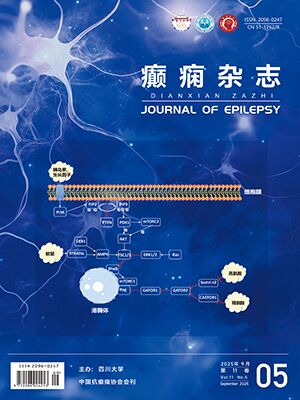| 1. |
Karoly PJ, Ung H, Grayden DB, et al. The circadian profile of epilepsy improves seizure forecasting. Brain, 2017, 140(8): 2169-2182.
|
| 2. |
Baud MO, Kleen JK, Mirro EA, et al. Multi-day rhythms modulate seizure risk in epilepsy. Nat Commun, 2018, 9(1): 1-10.
|
| 3. |
Morin LP. Neuroanatomy of the extended circadian rhythm system. Exp Neurol, 2013, 243(5): 4-20.
|
| 4. |
Reppert SM, WeaverDR, Ebisawa T. Cloning andcharacterization ofa mammalian melatonin receptor thatmediates reproductive and circadian responses. Neuron, 1994, 13(5): 1177-1185.
|
| 5. |
Gowers W. Epilepsy and other chronicconvulsivediseases: their causes, symptoms andtreatment. New York: WilliamWood, 1885: 157-164.
|
| 6. |
Van Campen JS, Valentijn FA, Jansen FE, et al. Seizure occurrence and the circadian rhythm ofcortisol: a systematic review. Epilepsy Behav, 2015, 47: 132-137.
|
| 7. |
Ramgopal S, Powell C, Zarowski M, et al. Predicting diurnal and sleep/wake seizure patterns in paediatric patients of different ages. Epileptic Disord, 2014, 16(1): 56-66.
|
| 8. |
Gurkas E, Serdaroglu A, Hirfanoglu T, et al. Sleep-wake distribution and circadian patterns of epileptic seizures in children. Eur J Paediatr Neurol, 2016, 20(4): 549-554.
|
| 9. |
Tinuper P, Bisulli F, Cross JH, et al. Definition and diagnostic criteria of sleep-related hypermotor epilepsy. Neurology, 2016, 86(19): 1834-1842.
|
| 10. |
Quigg M, Clayburn H, Straume M, et al. Hypothalamicneuronal loss and altered circadian rhythm of temperature in a rat model ofmesial temporal lobe epilepsy. Epilepsia, 1999, 40(12): 1688-1696.
|
| 11. |
Quigg M, Straume M, Smith T, et al. Seizures induce phaseshifts of rat circadian rhythms. Brain Res, 2001, 913(2): 165-169.
|
| 12. |
Quigg M, Clayburn H, Straume M, et al. Effects ofcircadian regulation and rest-activity state on spontaneous seizures in a ratmodel of limbic epilepsy. Epilepsia, 2000, 41(5): 502-509.
|
| 13. |
Persson H, Kumlien E, Ericson M, et al. Circadian variation in heart-ratevariability in localization-related epilepsy. Epilepsia, 2007, 48(5): 917-922.
|
| 14. |
Jenwitheesuk A, Nopparat C, Mukda S, et al. Melatonin regulates aging andneurodegeneration through energy metabolism, epigenetics, autophagy and circadianrhythm pathways. Int J Mol Sci, 2014, 15(9): 16848-16884.
|
| 15. |
Peled N, Shorer Z, Peled E, et al. Melatonin effect on seizures in children with severe neurologic deficit disorder. Epilepsia, 2001, 42(9): 1208-1210.
|
| 16. |
Sarabdjitsingh RA, Jezequel J, Pasricha N, et al. Ultradian corticosterone pulses balance glutamatergic transmission and synaptic plasticity. Proc Natl Acad Sci USA, 2014, 111(39): 14265-14270.
|
| 17. |
Bauer J. Epilepsy and prolactin in adults: a clinical review. Epilepsy Res, 1996, 24(1): 1-7.
|
| 18. |
Kasting N, Veale W, Cooper K, et al. Vasopressin may mediate febrile convulsions. Brain Res, 1981, 213(2): 327-333.
|
| 19. |
Albertson TE, Peterson SL, Stark LG, et al. The anticonvulsant properties of melatonin on kindled seizures in rats. Neuropharmacology, 1981, 20(1): 61-66.
|
| 20. |
Fauteck JD, Schmidt H, Lerchl A, et al. Melatonin in epilepsy: first results of replacement therapy and first clinical results. Biol SignRecep, 1999, 8(1-2): 105-110.
|
| 21. |
Ehlers CL, Henriksen SJ, Wang M, et al. Corticotropin releasing factor produces increases in brain excitability and convulsive seizures in rats. Brain Res, 1983, 278(1-2): 332-336.
|
| 22. |
Baram TZ, Schultz L. Corticotropin-releasing hormone is a rapid and potent convulsant in the infant rat. Brain Res, 1991, 61(1): 97-101.
|
| 23. |
Gray TS, Bingaman EW. The amygdala: corticotropin-releasing factor, steroids, and stress. Crit Rev Neurobiol, 1996, 10(2): 155-168.
|
| 24. |
BaramTZ, Mitchell WG, Tournay A, et al. High-dose corticotropin (ACTH) versus prednisone for infantile spasms: a prospective, randomized, blinded study. Pediatrics, 1996, 97(3): 375-379.
|
| 25. |
Pranzatelli M. On the molecular mechanism of adrenocorticotropin hormone in the CNS: transmitters and receptors. Exp Neurol, 1994, 125: 142-161.
|
| 26. |
Laakso ML, Leinonen L, Hatonen T, et al. Melatonin, cortisol and body temperaturerhythms in Lennox-Gastaut patients with or without circadian rhythm sleep disorders. J Neurol, 1993, 240(7): 410-416.
|
| 27. |
Schmutz M, Baud J, Glatt A, et al. Chronopharmacological investigations on tonic–clonic seizures on rats and their suppression by carbamazepine, oxcarbazepine, and diazepam. In: Dreifuss F, MeinardiH, Stefan H (Eds.), Chronopharmacology in Therapy of the Epilepsies. Raven Press, New York, 1993: 145-154.
|
| 28. |
Loddenkemper T, Lockley SW, Kaleyias J, et al. Chronobiology of epilepsy: diagnostic and therapeutic. J Clin Neurophysiol, 2011, 28(2): 146-153.
|




